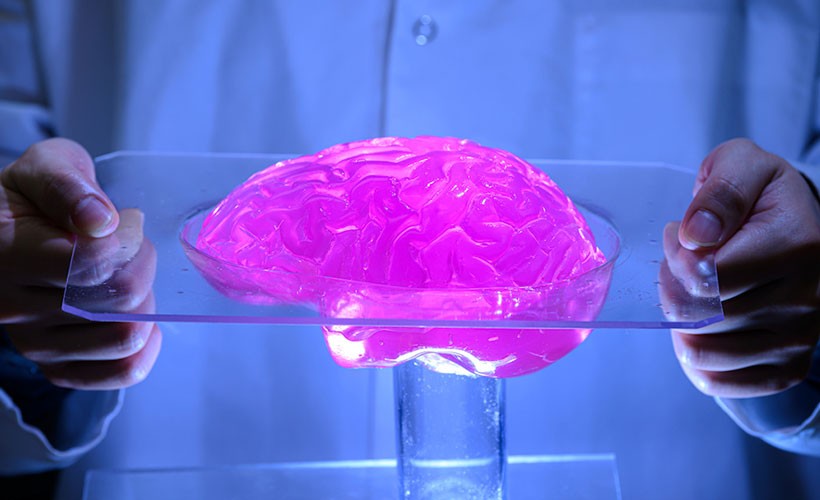SMART BRAIN

A biomimetic model of the human skull and brain to understand how concussion and TBI affect brain structure and function.
According to the Brain Injury Association, one in 60 adults is living with some form of disability related to traumatic brain injury (TBI). To develop more effective interventions for workers and athletes against concussions and TBI, such as helmets, in-depth knowledge is required of how brain matter moves within the skull and how these injuries affect brain structure and function.
The Smart Brain is a highly advanced research tool for understanding the link between impact and injury. It is the result of a novel synthesis of fluid mechanics, materials, instrumentation and manufacturing processes. The 3D-printed hydrogel brain sits within a transparent skull and mimics the geometry and mechanical properties of the human brain to provide insights into injury mechanics by: (1) determining how and why a brain injury occurred, (2) measuring cerebrospinal fluid pressurization and (3) recording acceleration and surface deformation data resulting from the impact.
RESEARCHERS
Principal Investigator
Qianhong Wu, PhD
Professor, Mechanical Engineering
Director, Cellular Biomechanics & Sports Science Lab
Students
Dr. Ji Lang, Qifu Wang, David Bates and Marissa Cucinotta
Partners
Dr. Liyun Wang, University of Delaware
Dr. Rungun Nathan, Penn State Berks
Dr. Pengtao Yue, Virginia Tech
Dr. James Feng, University of British Columbia, Canada
PROJECT DETAILS
Precise measurements of the motion and deformation of brain matter during impact will provide guidance toward the creation of more effective protective gear like helmets for athletes or workers in heavy industry.
The Smart Brain can accommodate patient-specific anatomical data to develop personalized treatments.
Patents:
- Wu, Q., Jen, K.-P., Townend, C.W., Nathan, R. Method and Apparatus for Examining Brain Injury due to Impact. United States Patent 10145677, December 4, 2018.
- Wu, Q., Ji Lang. APPARATUS FOR EXAMINING BRAIN INJURY, METHOD OF MAKING AND METHOD OF USING THE SAME. U.S. Patent 11559245, January 24, 2023.
NSF/EAGER:
- Wu, Q. (PI), Wang, L. (co-PI), National Science Foundation (NSF), 2023-2025, $297,942, “EAGER: Transient Cerebrospinal Fluid (CSF) Flow in Brain Concussion”
NBC 10: ‘Smart Brain' Could Help Doctors See Full Impact of Trauma
Philadelphia Magazine: This Lifelike Brain Could Help Doctors Prevent Traumatic Brain Injury
The Doctor’s Channel: Model Could Offer Noninvasive Way to Study Brain Injury
Lang, J. Nathan, R. and Wu, Q.*, 2021 How to deform an egg yolk? On the Study of the Soft Matter Deformation in a Liquid Environment. Physics of Fluids, 33, 011903. [Chosen as Featured cover Article and was reported in over 100 scientific journals and public media around the world]
Lang, J., Nathan, R., Zhou, D., Zhang, X., Li, B., and Wu, Q.*, 2021 Cavitation Causes Brain Injury. Physics of Fluids, 33:031908 [Chosen as Featured Article]
Lang, J., and Wu, Q.*, 2021 Modeling of the Transient Cerebrospinal Fluid Flow under External Impacts. European Journal of Mechanics - B/Fluids, 171–179.

